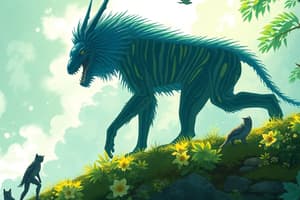Podcast
Questions and Answers
What is the result of genetic variation?
What is the result of genetic variation?
- Non-Random Mating
- Natural Selection
- Genetic Drift
- Mutation, Gene Flow between Population, and Sexual Reproduction (correct)
What is the process of transfer of genetic material from one population to another?
What is the process of transfer of genetic material from one population to another?
- Non-Random Mating
- Gene Flow (correct)
- Genetic Variation
- Natural Selection
Which of the following is an evidence of evolution?
Which of the following is an evidence of evolution?
- Geographic Distribution of Living Things
- Vestigial Organs
- Taxonomy
- All of the above (correct)
Which of the following is NOT a way to increase genetic variation in a population?
Which of the following is NOT a way to increase genetic variation in a population?
What is the principle that states that genetic variation in a population will remain constant from one generation to the next in the absence of disturbing factors?
What is the principle that states that genetic variation in a population will remain constant from one generation to the next in the absence of disturbing factors?
Who is considered the Father of Modern Taxonomy?
Who is considered the Father of Modern Taxonomy?
What is the fundamental concept of evolution?
What is the fundamental concept of evolution?
Who is credited with proposing that all species of life have descended from a common ancestor?
Who is credited with proposing that all species of life have descended from a common ancestor?
What is the process by which modern organisms have descended from ancient organisms?
What is the process by which modern organisms have descended from ancient organisms?
What is the term for the selective breeding imposed by humans to enhance desirable features?
What is the term for the selective breeding imposed by humans to enhance desirable features?
What is the concept that explains how giraffes developed long necks?
What is the concept that explains how giraffes developed long necks?
What is the random process that can lead to large changes in populations over a short period of time?
What is the random process that can lead to large changes in populations over a short period of time?
Flashcards are hidden until you start studying
Study Notes
Evolution and Origin of Biodiversity
- Evolution is the change in properties of groups of organisms over generations.
- Charles Darwin proposed that all species of life descended from a common ancestor.
Theory of Evolution
- Evolution is the process by which modern organisms descended from ancient organisms.
- A theory is a well-supported, testable explanation of natural phenomena.
Natural Selection and Artificial Selection
- Natural selection is the selection process that occurs due to an organism’s ability to adapt to its surroundings.
- Artificial selection is the selective breeding imposed by humans to enhance desirable features.
Lamarck's Theory of Evolution
- Tendency toward perfection (e.g., giraffe necks)
- Use and disuse (e.g., birds using forearms)
- Inheritance of acquired traits
Mechanisms of Genetic Variation
- Mutation: alteration in the nucleic acid sequence of the genome of an organism.
- Genetic drift: a random process that can lead to large changes in populations over a short period.
- Gene flow: transfer of genetic material from one population to another.
- Non-random mating: organisms mate with others of the same or different genotypes.
Genetic Variation
- Neutral: no problem
- Maladaptive: abnormalities
- Beneficial: increases fitness and mate selection
- Genetic variation can occur through mutation, gene flow, and sexual reproduction.
Hardy-Weinberg Theory
- The genetic variation in a population will remain constant from one generation to the next in the absence of disturbing factors.
- Factors that can disturb the equilibrium: mutation, natural selection, non-random mating, genetic drift, and gene flow.
Evidence of Evolution
- Fossil record: shows change over time
- Geographic distribution of living things: similar environments have similar types of organisms
- Homologous body structures: develop from the same embryonic tissue
- Similarities in early development
- Vestigial organs: serve no useful function in an organism
Taxonomy
- Branch of biology that groups and names organisms based on their characteristics.
- Carolus Linnaeus is considered the Father of Modern Taxonomy.
- Aristotle developed the first widely accepted system of biological classification.
- Binomial nomenclature: a standard two-part system for naming organisms.
- Specific epithet: describes a characteristic of the organism.
- Taxa: Linnaeus’ hierarchical system of classification includes 7 levels.
Studying That Suits You
Use AI to generate personalized quizzes and flashcards to suit your learning preferences.




